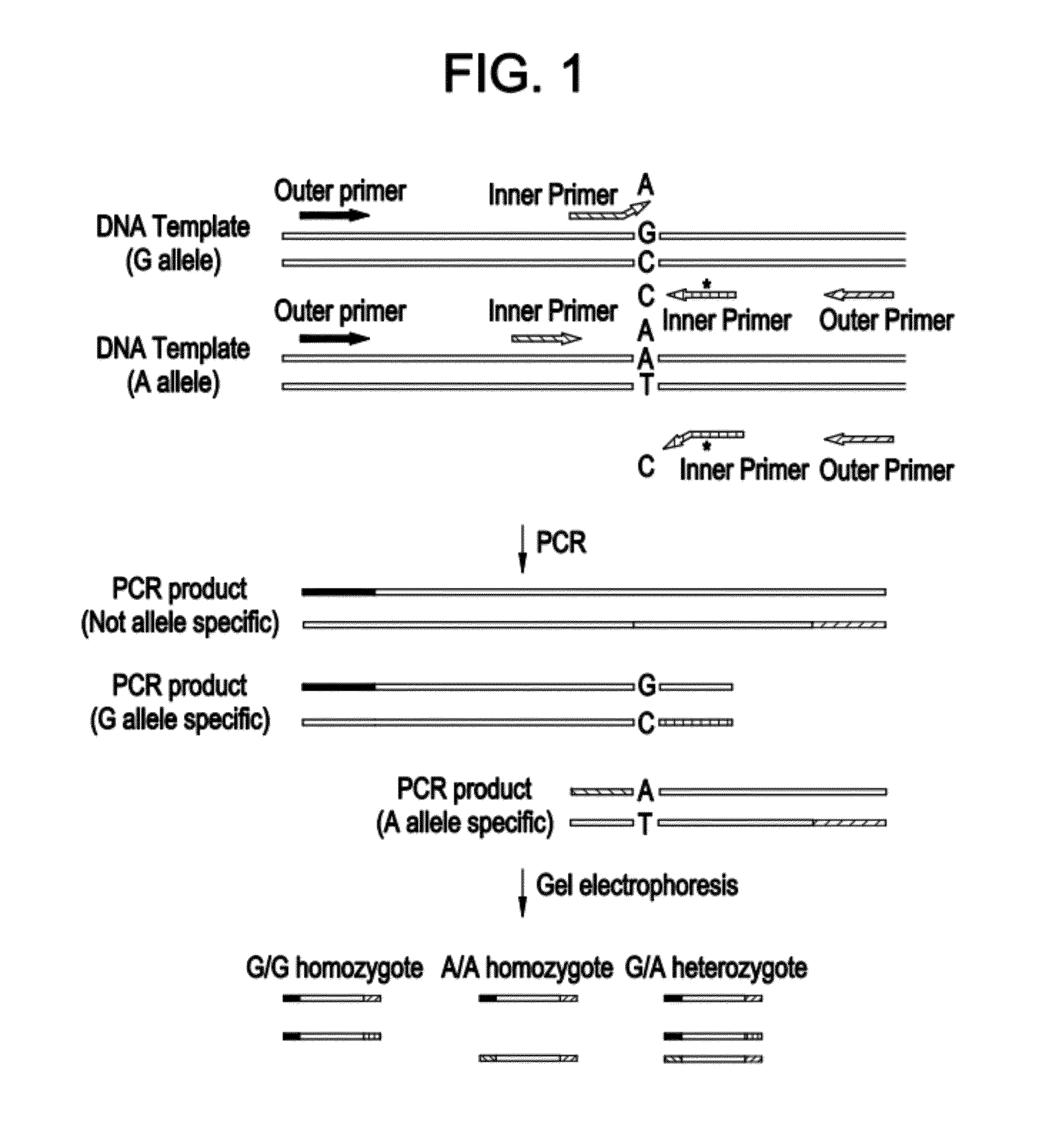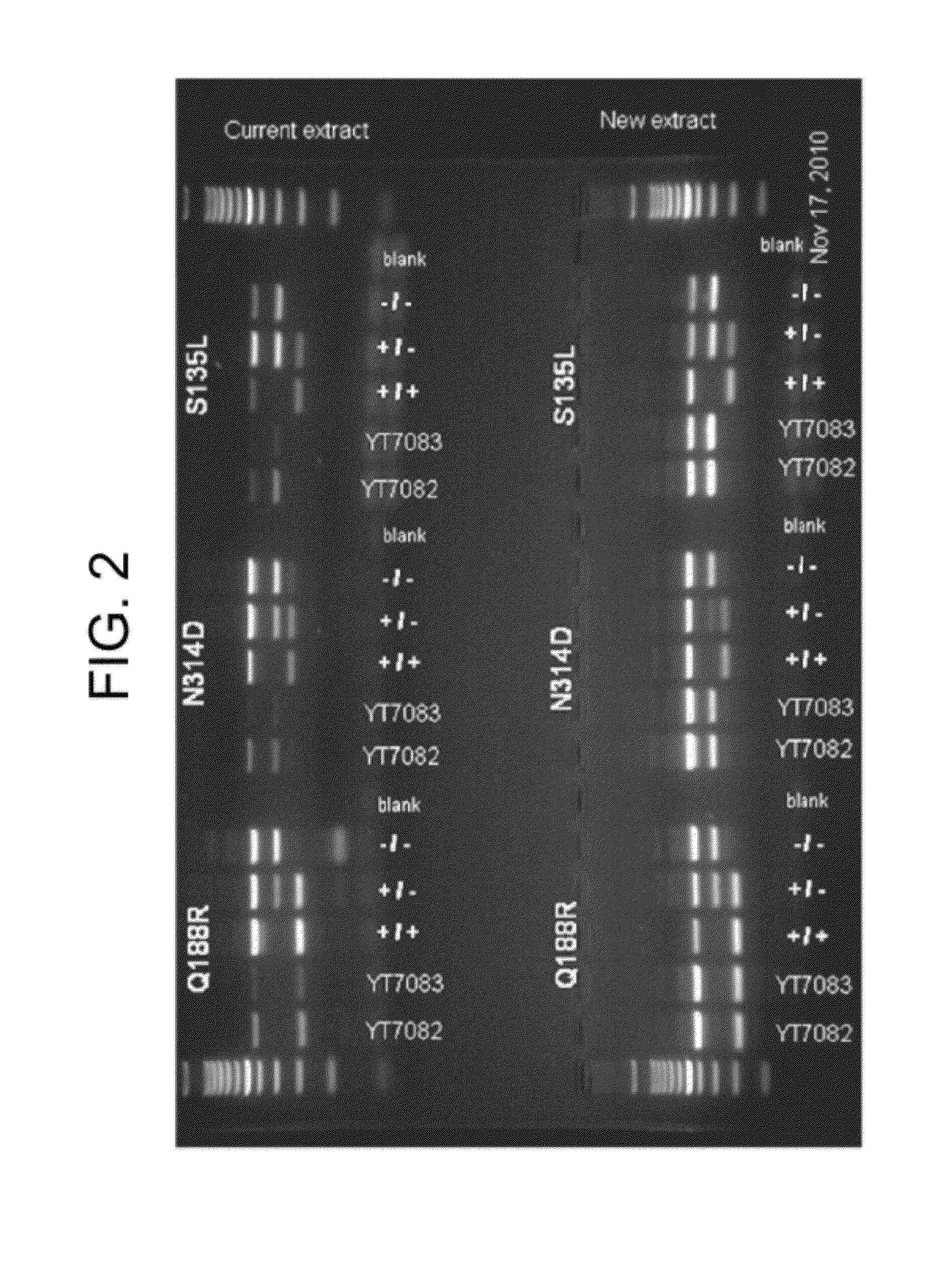One-step method of elution of DNA from blood samples
a blood sample and dna technology, applied in the field of elution can solve the problems of dna from blood samples, easy to adapt to high throughput format and automation, and save millions of dollars per year in health care costs
- Summary
- Abstract
- Description
- Claims
- Application Information
AI Technical Summary
Problems solved by technology
Method used
Image
Examples
example 1
DNA Elution from Dried Blood Samples Using a One-Step DNA Elution Buffer DNA Elution
[0049]A. Place 3.2 mm dried blood punches one per well into the wells of a multi-well plate.[0050]B. Add 54 μL of the one-step elution buffer into each well with an 8-Channel Pipette or an automatic liquid handler.[0051]C. Cover the plate with an adhesive cover.[0052]D. Centrifuge the plate at 3700 rpm for 5 minutes (optional).[0053]E. Heat the plate at 95° C. or greater for 25 minutes. Optionally, the eluted DNA solution is cooled at a temperature of at least about 4° C. for at least 5 minutes.[0054]F. Remove the plate from the thermal cycler, and allow the plate to cool to room temperature.
[0055]The one step buffer was: 15 mM Tris-Base, 10 mM KCl, and 5 mM KOH, pH 11.5.
[0056]After elution the solution is optionally centrifuged at 3700 rpm for 5 minutes before it is used in subsequent PCR reactions, however no additional solutions are added and no washing steps are performed.
example 2
Galatose-1-phosphate Uridyltransferase (GALT) Mutation Detection in Eluted DNA Using Tetra-Primer ARMS-PCR
[0057]Classic Galactosemia is an autosomal recessive inborn error of metabolism caused by deficiency of Galatose-1-phosphate Uridyltransferase (GALT). GALT gene targeted mutation analysis is performed as second tier testing after a GALT biochemical assay is done in newborn screening. The mutation panel includes p. Q188R, p. N134D, and p. S135L. With a Tetra-primer ARMS-PCR method, the internal control, wild type allele and mutant allele can be amplified simultaneously in a single reaction, and because of the applicons' difference in length, they can be distinguished by regular agarose gel electrophoresis. Tetra-primer ARMS-PCR is a hybrid of the tetra primer PCR method and the amplification refractory mutation system (ARMS). In Tetra-primer ARMS-PCR, both inner primers encompass a mutation at position-1 from the 3′-terminus which increases the specificity of ARMS-PCR. FIG. 1 is ...
example 3
Real-Time PCR Analysis for T-Cell Receptor Excision Circles
[0100]Severe combined immunodeficiency (SCID) is a group of disorders caused by over a dozen single-gene defects that cause a defect in the development of normal naïve T cells. The inventor of the present application previously developed an assay for detecting SCID in newborns by quantitating T-cell excision circles (TRECs) in dried blood spots. TRECs are small, episomal pieces of DNA generated during the process of T-cell receptor rearrangement. The number of TRECs is a surrogate marker for the number of naïve T-cells that have migrated from the thymus, and all forms of SCID are characterized by low numbers of detectable TRECs. TRECs can be quantified using a real-time PCR method. Serially diluted plasmids containing known numbers of TRECs can be used to produce a calibration curve. A TREC cut-off level of 75 or less TRECs per 3.2 mm dried blood sample is used to identify newborns with SCID. The primers and probes used in t...
PUM
| Property | Measurement | Unit |
|---|---|---|
| temperature | aaaaa | aaaaa |
| temperature | aaaaa | aaaaa |
| temperature | aaaaa | aaaaa |
Abstract
Description
Claims
Application Information
 Login to View More
Login to View More - R&D
- Intellectual Property
- Life Sciences
- Materials
- Tech Scout
- Unparalleled Data Quality
- Higher Quality Content
- 60% Fewer Hallucinations
Browse by: Latest US Patents, China's latest patents, Technical Efficacy Thesaurus, Application Domain, Technology Topic, Popular Technical Reports.
© 2025 PatSnap. All rights reserved.Legal|Privacy policy|Modern Slavery Act Transparency Statement|Sitemap|About US| Contact US: help@patsnap.com



